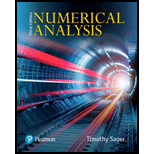
Concept explainers
A remarkable three-body figure-eight orbit was discovered by C. Moore in 1993. In this configuration, three bodies of equal mass chase one another along a single figure-eight loop. Set the masses to
and gravity
. (a) Adapt orbit. mto plot the trajectory with initial conditions
Want to see the full answer?
Check out a sample textbook solution
Chapter 6 Solutions
Numerical Analysis
- Force Repeat Problem 43 for a 25.0-pound weight and a bench inclined at 12.5.arrow_forwardas engineer design a cooling tower in the shape of hyperboloid of one sheet. The horizontal cross sections of the cooling tower are circular with 10m.The cooling tower is 40m tall with maximum cross-sectional radius of 15m. (A) Construct a mathematical equations for this cooling tower. (B) If x=a cos(u) cosh(v) ,y=b sin(u) cosh(v) and z= csinh(v), show that (x,y,z)lies on your equation in Q1(A). (C) A colleague at the same institution want to construct the cooling tower using an hyperbolic cylinder, give reasons for your result in Q1(A) as the best model for the design of cooling tower.arrow_forwardIn the figure, block A (mass 1.8 kg) slides into block B (mass 2.4 kg), along a frictionless surface. The directions of velocities before and after the collision are indicated; the corresponding speeds are vAi = 5.2 m/s, VBj = 2.2 m/s, and vef = 4.3 m/s. What is velocity vaf (including sign, where positive denotes motion to the right)? Number i Unitsarrow_forward
- (a) Find three parametrizations that give the same graph as the given equation. (b) Find three parametrizations that give only a portion of the graph of the given equation.y = x2arrow_forwardNow measure and record the period for small angle motion with a stopwatch (there is no angle too small, so long as you can see it move). Measure the period in the following way: Move the mass away from equilibrium. Start a stopwatch and simultaneously release the mass. Stop the stopwatch after it swings 5 times back and forth. Record this value. Now acquire 5 more periods this way (each with five swings) so that you have six measures of the period of the same pendulum. Q2: What is the period of the pendulum written as mean +/- error while using a 95% confidence interval? Measurement #1: 3.17 Seconds (Period - T=0.634) Measurement #2: 2.95 Seconds (Period - T=0.590) Measurement #3: 3.25 Seconds (Period - T=0.650) Measurement #4: 3.16 Seconds (Period - T=0.632) Measurement #5: 3.17 Seconds (Period - T=0.634) Measurement #6: 3.22 Seconds (Period - T=0.644) Mean = 3.784/6=0.630 I do not understand how to produce the error +/- while using the 95% confidence interval. Could you please help…arrow_forwardster Com... sin(-3pi/2 McGraw-Hill Conn.. MywCC Q Chapter 1 Flashca... 6 / 6 100% (y+2)2 = 1. x2 16. Find the center, vertices, and foci of the ellipse given by the equation 16 49 14,588 1 37 Ps MacBook Pro Display Connected: Mirror Displays Extend Desktop & 4 5 7 8arrow_forward
- A frog is sitting on the edge of a playground carousel with radius 1 meter. The ray through the frog's position and the center of the carousel makes an angle of measure e with the horizontal, and his starting coordinates are approximately (0.81, 0.59). Find his new coordinates after the carousel rotates by each of the following amounts. a. 2 z*+ y* = 1 C. d. (0.81,0.59) 2 е. - f. 2 g. T- 20 h. -20 b.arrow_forwardsuppose that an airplane main- tains a heading toward an airport at the origin. If vo = 500 mi/h and w = 50 mi/h (with the wind blowing due north), and the plane begins at the point (200, 150), show that its trajectory is described by y + Vx2 + y2 = 2(200.x°)'/10.arrow_forwardEvaluate the dP/dT of the equation by keeping V constant, and a & b are temperature-indepent paramaters.arrow_forward
- Algebra & Trigonometry with Analytic GeometryAlgebraISBN:9781133382119Author:SwokowskiPublisher:Cengage
 Trigonometry (MindTap Course List)TrigonometryISBN:9781305652224Author:Charles P. McKeague, Mark D. TurnerPublisher:Cengage Learning
Trigonometry (MindTap Course List)TrigonometryISBN:9781305652224Author:Charles P. McKeague, Mark D. TurnerPublisher:Cengage Learning

